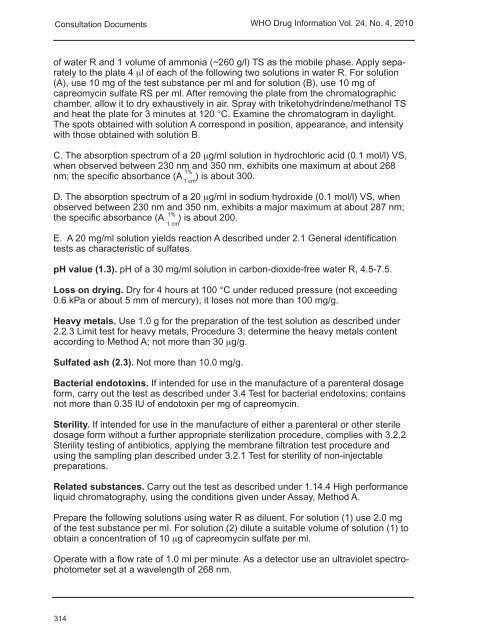WHO Drug Information Vol. 24, No. 4, 2010
WHO Drug Information Vol. 24, No. 4, 2010
WHO Drug Information Vol. 24, No. 4, 2010
Create successful ePaper yourself
Turn your PDF publications into a flip-book with our unique Google optimized e-Paper software.
Consultation Documents<strong>WHO</strong> <strong>Drug</strong> <strong>Information</strong> <strong>Vol</strong>. <strong>24</strong>, <strong>No</strong>. 4, <strong>2010</strong>of water R and 1 volume of ammonia (~260 g/l) TS as the mobile phase. Apply separatelyto the plate 4 µl of each of the following two solutions in water R. For solution(A), use 10 mg of the test substance per ml and for solution (B), use 10 mg ofcapreomycin sulfate RS per ml. After removing the plate from the chromatographicchamber, allow it to dry exhaustively in air. Spray with triketohydrindene/methanol TSand heat the plate for 3 minutes at 120 °C. Examine the chromatogram in daylight.The spots obtained with solution A correspond in position, appearance, and intensitywith those obtained with solution B.C. The absorption spectrum of a 20 µg/ml solution in hydrochloric acid (0.1 mol/l) VS,when observed between 230 nm and 350 nm, exhibits one maximum at about 2681%nm; the specific absorbance (A ) is about 300.D. The absorption spectrum of a 20 µg/ml in sodium hydroxide (0.1 mol/l) VS, whenobserved between 230 nm and 350 nm, exhibits a major maximum at about 287 nm;1%the specific absorbance (A ) is about 200.1 cm1 cmE. A 20 mg/ml solution yields reaction A described under 2.1 General identificationtests as characteristic of sulfates.pH value (1.3). pH of a 30 mg/ml solution in carbon-dioxide-free water R, 4.5-7.5.Loss on drying. Dry for 4 hours at 100 °C under reduced pressure (not exceeding0.6 kPa or about 5 mm of mercury); it loses not more than 100 mg/g.Heavy metals. Use 1.0 g for the preparation of the test solution as described under2.2.3 Limit test for heavy metals, Procedure 3; determine the heavy metals contentaccording to Method A; not more than 30 µg/g.Sulfated ash (2.3). <strong>No</strong>t more than 10.0 mg/g.Bacterial endotoxins. If intended for use in the manufacture of a parenteral dosageform, carry out the test as described under 3.4 Test for bacterial endotoxins; containsnot more than 0.35 IU of endotoxin per mg of capreomycin.Sterility. If intended for use in the manufacture of either a parenteral or other steriledosage form without a further appropriate sterilization procedure, complies with 3.2.2Sterility testing of antibiotics, applying the membrane filtration test procedure andusing the sampling plan described under 3.2.1 Test for sterility of non-injectablepreparations.Related substances. Carry out the test as described under 1.14.4 High performanceliquid chromatography, using the conditions given under Assay, Method A.Prepare the following solutions using water R as diluent. For solution (1) use 2.0 mgof the test substance per ml. For solution (2) dilute a suitable volume of solution (1) toobtain a concentration of 10 µg of capreomycin sulfate per ml.Operate with a flow rate of 1.0 ml per minute. As a detector use an ultraviolet spectrophotometerset at a wavelength of 268 nm.314

















